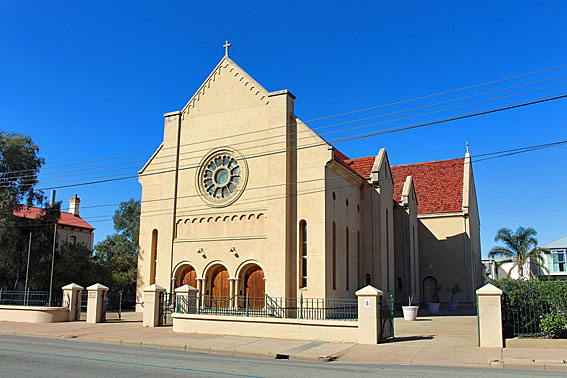
St Mark's Catholic Cathedral, Port Pirie: exterior
[photograph by Trevor Bunning (October 2019)]

St Mark's Catholic Cathedral, Port Pirie: exterior
[photograph by Trevor Bunning (October 2019)]
Historical and Technical Documentation by John Maidment
© OHTA, 2019 (last updated October 2019)
The original Catholic church at Port Pirie was opened on 9 July 1883; the architect was C. Polain. It was destroyed by fire in October 1947. A new church (which became a Cathedral upon the establishment of a new diocese) was dedicated on 1 March 1953. It was designed by the Adelaide architectural partnership of Russell & Yelland and designed in a Romanesque style. Built by L. O'Loughlin in brick, it provided seating for 700 and was 149 feet long and 36 feet high; the cost was £64,946.1

Elder Hall, University of Adelaide: case of the 1901 J.E. Dodd organ
[photograph from collection of State Library of South Australia]
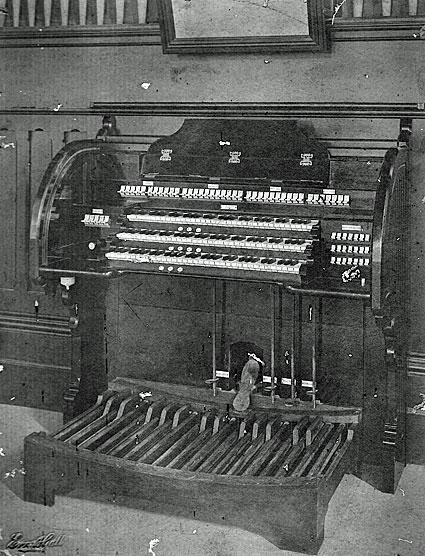
Elder Hall, University of Adelaide: console of the 1901 J.E. Dodd organ
[photograph from collection of John Maidment, ex Ray Sanders]
The organ was built by J.E. Dodd for Elder Hall within the University of Adelaide and opened on 20 July 1901.2 With three manuals, 32 speaking stops and 10 couplers, this was the largest instrument so far to have been built by Dodd and was widely acclaimed for its progressive tonal qualities and console incorporating stopkeys, possibly after a patent taken out by British organbuilder Arthur Henry Whinfield. The electric blowing plant, made by Sturtevant, of Boston, was probably the first in South Australia. The manual key actions were tracker, with lever pneumatic actions used for the basses. Tubular-pneumatic action was used for the stops and Pedal division.
| GREAT Double Open Diapason Open Diapason Claribel Viola Claribel Principal Harmonic Flute Fifteenth Mixture Tromba Swell to Great Sub Swell to Great Swell to Great Super Choir to Great Sub Choir to Great Choir to Great Super |
16 8 8 8 8 4 4 2 3 ranks 8 |
A B |
|
| SWELL Lieblich Bourdon Geigen Principal Hohl Flute Aeoline Celeste Octave Flauto Traverso Mixture Cornopean Oboe Vox Humana Tremulant |
16 8 8 8 8 4 4 3 ranks 8 8 8 |
TC (by hitching pedal) |
|
| CHOIR (unenclosed) Viole d'Orchestre Gedacht Dulciana Lieblich Flute Flageolet Clarionet Orchestral Oboe Swell to Choir |
8 8 8 4 2 8 8 |
||
| PEDAL Open Diapason [wood] Open Diapason [metal] Bourdon Violoncello Space for 16 reed Pedal Octave Great to Pedal Swell to Pedal Choir to Pedal |
16 16 16 8 16 |
A B |
|
| Compass: 61/30 Balanced swell pedal 3 pistons to Great 3 pistons to Swell 1 Full to Great 1 Full to Swell 1 Grand Full Organ Electric blowing Adjustable stool3 |
It was rebuilt by Dodd in 1934, incorporating a new electro-pneumatic action, an attached drawstop console, a lowering of pitch, enclosure of the Choir Organ and adjustable pistons, with many tonal additions including a Tibia Clausa. The instrument was reopened on 27 August 1934.4 Apart from the transposition of several stops on the Choir Organ to form a Nazard and Tierce, the instrument remained unaltered until its removal from the hall in the late 1970s. It was frequently used for broadcasts on the ABC program Organists of Australia and performed upon by organists such as J.V. Peters and James Govenlock.
| GREAT Double Diapason Contra Dulciana Phonon Diapason Open Diapason Tibia Clausa Viola Claribel Dulciana Octave Diapason Harmonic Flute Fifteenth Mixture Ophicleide Tuba Horn Clarion Swell to Great Sub Swell to Great Swell to Great Super Choir to Great Sub Choir to Great Choir to Great Super |
16 16 8 8 8 8 8 8 4 4 2 III 16 8 4 |
A B C B D D D |
|
| SWELL Lieblich Bourdon Open Diapason Hohl Flute Aeoline Celeste Principal Flauto Traverso Mixture Cornopean Oboe Vox Humana Tremulant Sub Octave Super Octave |
16 8 8 8 8 4 4 III 8 8 8 |
E TC |
|
| CHOIR Contra Viol Viol di Orchestra Lieblich Gedackt Dulcissima Lieblich Flute Flautina Clarinet Orchestral Oboe Contra Fagotto Tromba Clarion Tremulant Sub Octave Super Octave Swell Sub Octave to Choir Swell to Choir Swell Octave to Choir |
16 8 8 4 4 2 8 8 16 8 4 |
(enclosed except loud reeds) F F D D D |
|
| PEDAL Sub Bass Acoustic Bass Major Bass Open Diapason Sub Bass Echo Bass Contra Viol Dolce Violoncello Lieblich Flute Viol di Orchestra Trombone Tuba Clarion Great to Pedal Swell to Pedal Choir to Pedal5 |
32 32 16 16 16 16 16 16 8 8 8 16 8 4 |
H G G A H E F B C E F D D D |

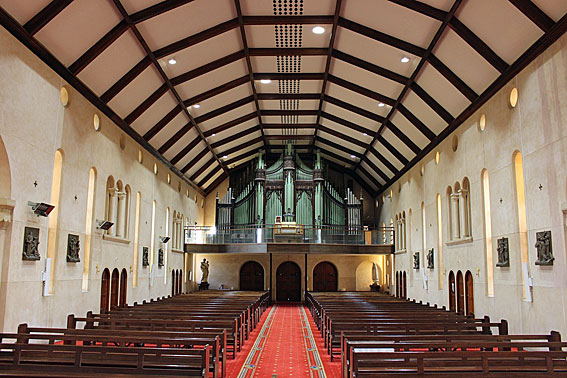
St Mark's Catholic Cathedral, Port Pirie: Dodd organ rebuilt in rear gallery
[photographs by Trevor Bunning (October 2019)]
It was sold to St Mark's Catholic Cathedral, in Port Pirie, receiving an extensive rebuilding by J.E. Dodd & Sons Gunstar Organ Works. This included a new detached drawstop console and many tonal changes. The original Dodd case and pipework were retained. The instrument was reopened on 2 September 1979 with Adelaide cathedral organists and university lecturers James Govenlock and David Swale giving the opening recital.
| GREAT Double Diapason Open Diapason I Open Diapason II Stopped Diapason Viola Dulciana Principal Rohr Flöte Twelfth Fifteenth Mixture Trumpet Clarion Swell to Great Swell Octave to Great Choir to Great Choir Octave to Great Solo on Great Off Choir |
16 8 8 8 8 8 4 4 2-2/3 2 III 8 4 |
A B B |
|
| SWELL Lieblich Bourdon Open Diapason Hohl Flöte Gedeckt Viole d'Orchestre Celeste Octave Flauto Traverso Nazard Fifteenth Mixture Double Cornopean Cornopean Oboe Vox Humana Tremulant Swell Super Swell Unison Off |
16 8 8 8 8 8 4 4 2-2/3 2 V 16 8 8 8 |
C TC D D |
|
| CHOIR Open Diapason Lieblich Gedeckt Principal Lieblich Flute Nazard Octave Flautino Tierce Spitz Quinte Super Octave Cymbel Oboe Shalmey Trompette en Chamade Tremulant Swell to Choir Swell Octave to Choir |
8 8 4 4 2-2/3 2 2 1-3/5 1-1/3 1 III 8 8 |
E F TC |
|
| SOLO (BOMBARDE) Trombone Tromba Trumpet Octave Tromba Trompette en Chamade |
16 8 8 4 8 |
shared with Choir G G B G F TC |
|
| SOLO Harmonic Flute Gedeckt Aeoline Octave Aeoline Oboe Shalmey Clarinet Tremulant |
8 8 8 4 8 8 |
shared with Choir C H H E |
|
| PEDAL Double Wood Bass Open Wood Bass Open Diapason Bourdon Dulciana Octave Diapason Open Flute Aeoline Quinte Super Octave Stopped Flute Octave Flute Mixture III Trombone Cornopean Trumpet Oboe Shalmey Great to Pedal Swell to Pedal Choir to Pedal |
32 16 16 16 16 8 8 8 5-1/3 4 4 2 III 16 16 8 4 |
I I A J H C G D B E |
Great and Pedal Pistons Coupled
Compass: 61/30
Electro-pneumatic action
Detached drawstop and stopkey console6
1 Recorder, 4 March 1953, p.2
2 Advertiser, 22 July 1901, p.6
3 Evening Journal, 22 July 1901, p.3 (this includes a reproduction of Dodd's case design)
4 Advertiser, 11 August 1934, p.20
5 Specification from Bruce Allan Naylor, Gazetteer of Organs in South Australia (thesis, University of Adelaide, 1969), pp.13-16 and personal inspection by author 1966, 1973
6 Specification from photographs taken by Trevor Bunning and history of the organ written by Isaac Ellis and issued by the church
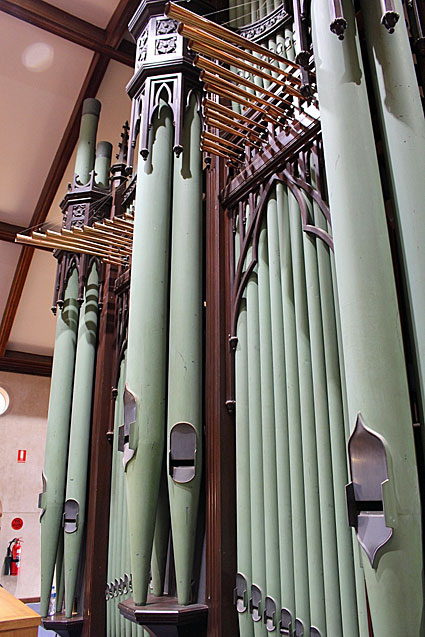
St Mark's Catholic Cathedral, Port Pirie: case detail showing Trompette en Chamade
[photograph by Trevor Bunning (October 2019)]
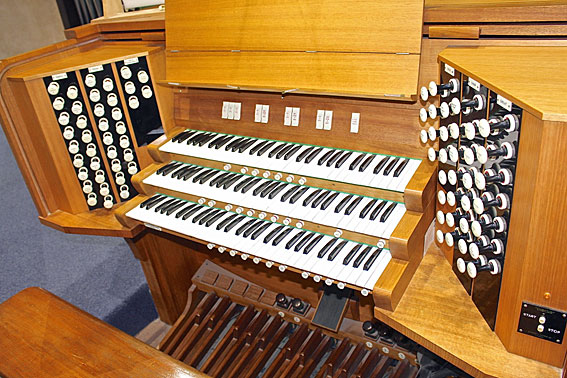
St Mark's Catholic Cathedral, Port Pirie: console
[photograph by Trevor Bunning (October 2019)]
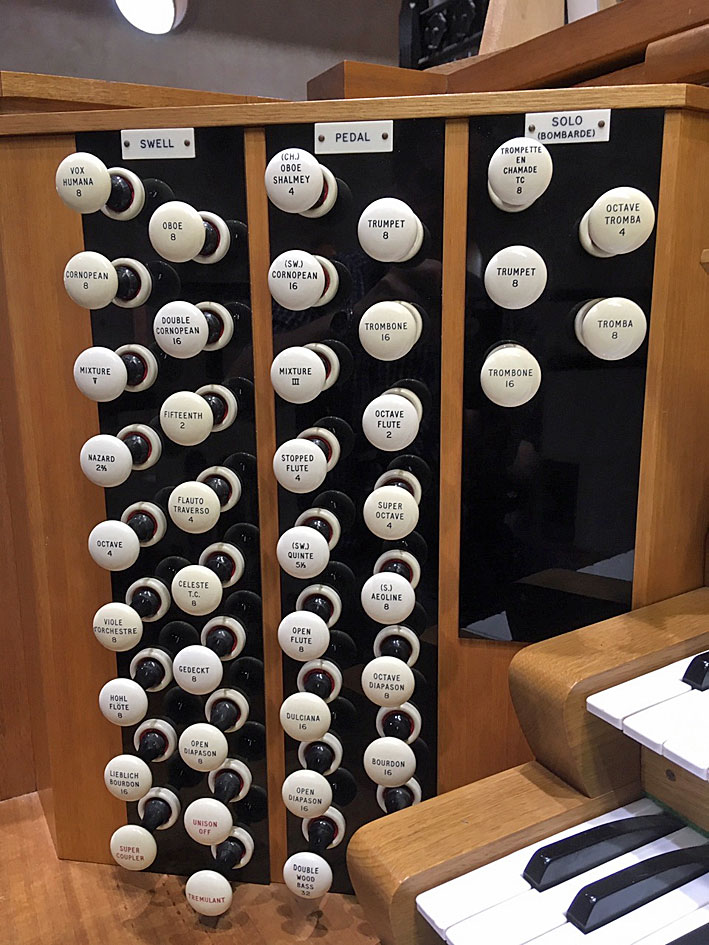
St Mark's Catholic Cathedral, Port Pirie: left-hand stop jamb
[photograph by Trevor Bunning (October 2019)]
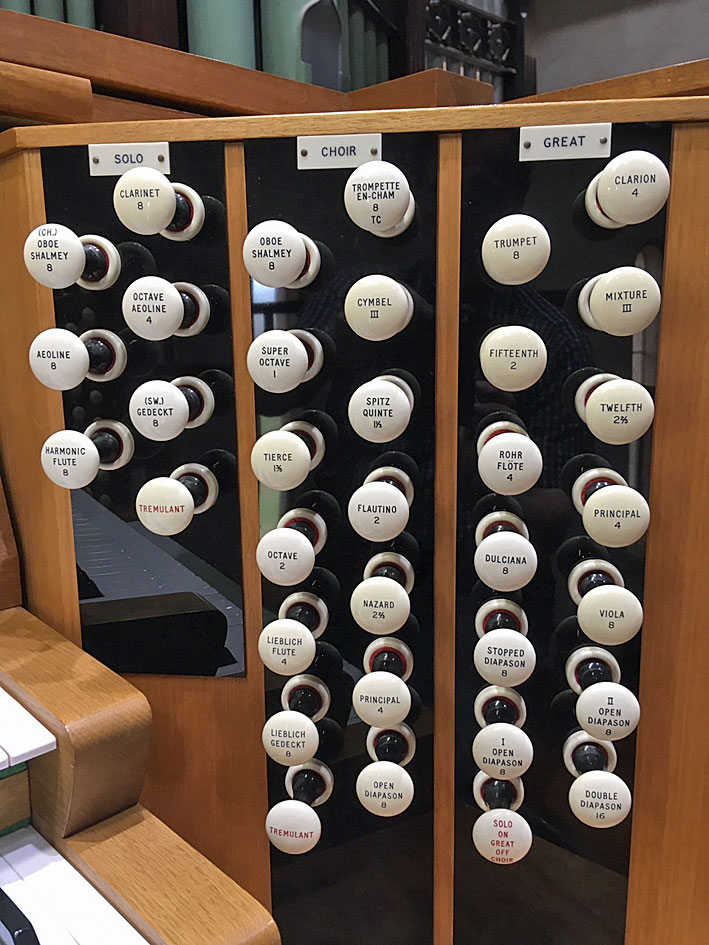
St Mark's Catholic Cathedral, Port Pirie: right-hand stop jamb
[photograph by Trevor Bunning (October 2019)]
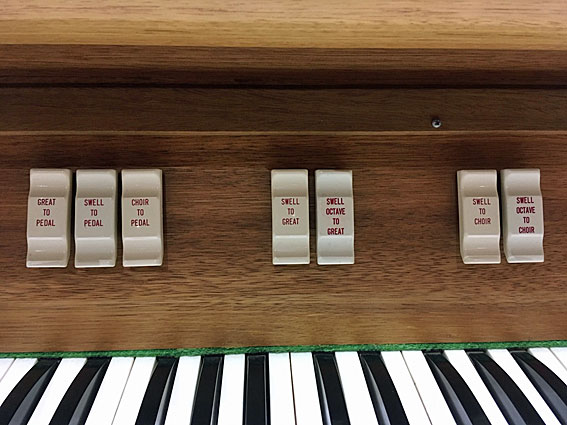
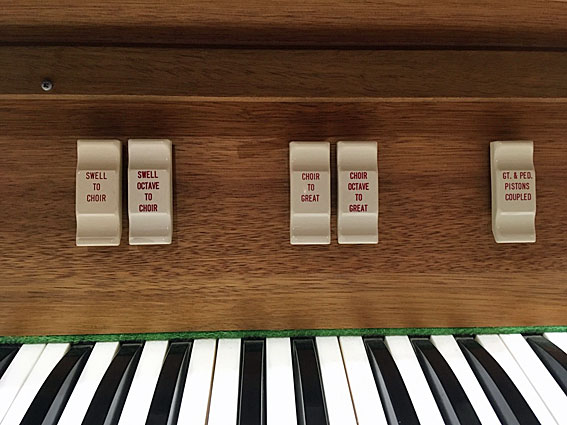
St Mark's Catholic Cathedral, Port Pirie: couplers
[photograph by Trevor Bunning (October 2019)]
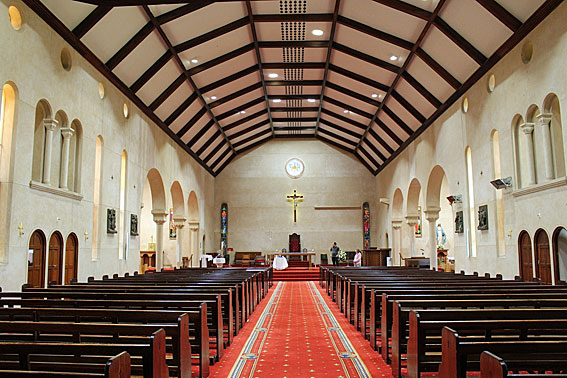
St Mark's Catholic Cathedral, Port Pirie: nave
[photograph by Trevor Bunning (October 2019)]